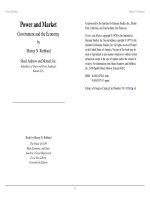yale university press one state two states resolving the israel palestine conflict apr 2009
Bạn đang xem bản rút gọn của tài liệu. Xem và tải ngay bản đầy đủ của tài liệu tại đây (639.63 KB, 257 trang )
One State, Two States
This page intentionally left blank
One State,
Two States
Resolving the Israel/Palestine Conflict
Benny Morris
yale university press new haven & london
Copyright © 2009 by Benny Morris.
All rights reserved.
This book may not be reproduced, in whole or in part, including illustrations,
in any form (beyond that copying permitted by Sections 107 and 108 of
the U.S. Copyright Law and except by reviewers for the public press),
without written permission from the publishers.
Set in Janson Text type by Integrated Publishing Solutions.
Printed in the United States of America.
Library of Congress Cataloging-in-Publication Data
Morris, Benny, 1948–
One state, two states : resolving the Israel/Palestine conflict / Benny Morris.
p. cm.
Includes bibliographical references and index.
isbn 978-0-300-12281-7 (clothbound : alk. paper)
1. Arab-Israeli conflict—Peace. 2. Israel-Arab War, 1948–1949—Influence.
3. Israel-Arab War, 1948–1949—Causes. 4. Jewish-Arab relations—History—
1947–1948. 5. Palestinian Arabs—Politics and government. 6. Palestine—
Politics and government—1917–1948. 7. Israel—Politics and government.
8. Zionism—History. I. Title.
ds119.7.m6565 2009
956.9405'4—dc22 2008040285
A catalogue record for this book is available from the British Library.
This paper meets the requirements of ANSI/NISO
Z39.48–1992 (Permanence of Paper).
It contains 30 percent postconsumer waste (PCW)
and is certified by the Forest Stewardship Council (FSC).
10987654321
Disclaimer: Some images in the printed version of this
book are not available for inclusion in the eBook.
Contents
acknowledgments vii
maps viii
list of abbreviations xv
1 The Reemergence of One-Statism 1
2 The History of One-State and Two-State Solutions 28
3 Where To? 161
notes 203
bibliography 223
index 230
This page intentionally left blank
Acknowledgments
I would like to thank Professors Beni Kedar, Ruth Gavison, and
Ron Zweig, as well as the anonymous readers, for reading and
commenting on the manuscript. Their suggestions and correc-
tions have added much to the quality of the outcome.
I would like to thank Jeff Abel for, as usual, sorting out various
technical issues.
My thanks, too, to Georges Borchardt and Jonathan Brent for
making the book possible and to Laura Jones Dooley for helping
fashion the outcome.
vii
viii
The Peel Commission partition proposal, July 1937.
ix
The UN General Assembly partition proposal, November 1947.
x
Israel and the Occupied Territories, 11 June 1967.
The Allon Plan, 1967–1968.
xii
Maps reflecting the actual Israeli proposal at Camp David (above) and
the Palestinian characterization of the final proposal (facing page) at
Camp David, July 2000.
xiii
Map reflecting Clinton’s “parameters,” December 2000.
Abbreviations
AHC Arab Higher Committee
CO Colonial Office (United Kingdom)
CZA Central Zionist Archive
DFLP Democratic Front for the Liberation of Palestine
DOP Declaration of Principles
FO Foreign Office (United Kingdom)
FRUS Foreign Relations of the United States
HHA Hashomer Hatza‘ir Archive
IDF Israel Defense Forces
ISA Israel State Archive
IZL Irgun Zvai Leumi (National Military Organiza-
tion or “Irgun”)
JNF Jewish National Fund
xv
LHI Lohamei Herut Yisrael (Freedom Fighters of
Israel or “Stern Gang”)
NA National Archives (United States)
PA or PNA Palestinian Authority or Palestinian National
Authority
PFLP Popular Front for the Liberation of Palestine
PLO Palestine Liberation Organization
PNC Palestine National Council
PRO Public Record Office (United Kingdom
National Archives)
UN United Nations
UNSCOP United Nations Special Committee on Palestine
Abbreviations
xvi
1 The Reemergence of One-Statism
Palestinian Arab Islamic fundamentalists, of the Hamas and Is-
lamic Jihad varieties, have always advocated the elimination of
Israel and a one-state—a Muslim Arab state—solution for the
Israel/Palestine problem. But over the past few years, Palestinian
Arab intellectuals linked to the mainstream Fatah Party and liv-
ing in the West have also begun talking openly about the desir-
ability, or at least the inevitability, of a one-state solution—one
state between the Jordan River and the Mediterranean, inhabited
by both Arabs and Jews. This marks a break from their at least
superficial espousal during the1990s of a two-state solution and a
reversion to the openly enunciated policy of the Fatah and Pales-
tinian Liberation Organization in the 1960s and 1970s, as em-
bodied in the Palestinian National Covenant, which posited the
elimination of the Jewish state and the establishment in its stead
1
of an Arab-dominated polity encompassing the territory of Israel
and the (at present) semioccupied West Bank and Gaza Strip.
For many of these “Western” Palestinians, this represents
nothing more than an emergence from the closet. In fact, these
current one-staters never really identified with the Fatah’s pro-
fessed advocacy in the 1990s of a two-state solution, with a parti-
tioned Palestine divided into two states, one Jewish, the other
Arab, living side by side in peaceful coexistence. Like their
cousins in Palestine, both inside Israel and in the West Bank and
Gaza Strip, and in the main concentrations of the Palestinian
diaspora—Jordan, Lebanon, and Syria—they had always believed,
and continue to believe, that all of Palestine belongs to them, the
Palestinian Arabs; that a Jewish state in any part of Palestine is
illegitimate and immoral; and that, in the fullness of time, the
whole country will eventually revert to Arab sovereignty. But
the Western—American and European—governmental two-
state mantra and the PLO’s apparent adoption of two-statism in
the late 1980s and early 1990s forced them underground or into
a duplicitous advocacy of, or reluctant acquiescence in, the two-
state formula.
Now these Arab one-staters—the “all of Palestine is ours”
advocates—are surfacing once again, loudly proclaiming the
truth and justice of their cause. Ghada Karmi, a British Palestin-
ian activist, perhaps heralded the trend with her article (albeit
published in Arabic, in 2002) “A Secular Democratic State in
Historic Palestine: An Idea Whose Time Has Come?” The ques-
The Reemergence of One-Statism
2
tion mark is misleading: the piece is quite emphatic about the un-
acceptability (to the Palestinians), indeed, death, of the two-state
paradigm and the ineluctability of the one-state solution. She
suggests that it might begin with “a formal policy of binational-
ism” that “may even ultimately pave the way to the secular
democratic state in historic Palestine.” (I shall return to the “sec-
ular democratic state” formula later.)
More significant still is Palestinian American historian Rashid
Khalidi’s admittedly cagey though ultimately unambiguous ex-
position of the one-state position in The Iron Cage (2006). He
maintains in this book that his exposition does not “involve advo-
cacy.” But even a minimally perceptive reader will not miss
where his heart and mind lie.
He writes: “Among some observers . . . a realization has been
growing for years that this outcome [that is, a two-state solution]
is increasingly unlikely. This realization has taken shape irre-
spective of the merits or demerits in principle of the two-state
solution, in spite of the long-standing desire of majorities of
Palestinians and Israelis for their own state, and notwithstanding
the (often grudging and hedged) acceptance by each people of a
state for the others . . . In this view, the inexorable cementing of
Israel’s hold over the occupied West Bank and East Jerusalem has
rendered moot the possibility of establishing what could legiti-
mately be called a Palestinian state [alongside Israel] . . . This is
the case if a ‘Palestinian state’ is taken to mean a viable, contigu-
ous, sovereign, independent state on the territory of the 22 per-
The Reemergence of One-Statism
3
cent of mandatory Palestine constituted by the Palestinian terri-
tories occupied by Israel in June 1967.” This realization has “in-
stigated renewed consideration of the old idea of a one-state
solution, as either the ideal outcome or as the most likely de-
fault outcome, for Palestine/Israel.” According to Khalidi, some
see this one-state denouement as the “inevitable outcome of
the extension into the immediate future of current trends . . .
[These trends, amounting to] inexorable creeping de facto an-
nexation [by Israel] of the West Bank and East Jerusalem, . . . will
produce what is in effect a single sovereign Israeli-dominated
polity throughout Palestine, with either rough Arab-Jewish de-
mographic parity or, more likely, an eventual Arab majority. In
this scenario, some feel, in time it will prove impossible to keep
the two peoples in one tiny land segregated, or to keep that
polity Jewish-dominated, as it eventually became impossible to
keep South Africa white-dominated.”
1
Khalidi adds: “There is little reflection among those who
hold this [one-state] conception about the future constitutional
structure or political arrangements between the two peoples . . .
Similarly, there is little consideration of how it would be possible
in such a single state to overcome either the apparent desire of
both peoples for independent statehood, or the deep and abiding
distrust of each collectivity toward the other.”
According to Khalidi, there is another group of one-staters
whose thinking is a “throwback to the old Palestinian idea of a
single unitary state of Palestine . . . [either] in terms of the previ-
The Reemergence of One-Statism
4
ous PLO conception of a secular, democratic state in all of Pales-
tine with equal rights for all . . . [or] in terms of an Islamic state
in which non-Muslims would be tolerated minorities.”
A last group of one-staters, according to Khalidi’s definitions,
are those who advocate “a binational approach . . . [that] would
take into account . . . [the] two national realities within the
framework of one state.” Khalidi acknowledges that all the one-
state approaches have not taken real account of the “stone wall”
of Israeli and American rejection of the dismantling of the
Jewish state and run counter to the international warrant of le-
gitimacy for Jewish statehood (and Palestinian Arab statehood)
issued by the UN General Assembly partition resolution (num-
ber 181) of November 1947.
2
The precipitants to this newfound candor about the desirability,
or at least the inevitability, of a single state between the Mediter-
ranean Sea and the Jordan River (and often the assertion of
“inevitability” is mere camouflage for the propagation of its “de-
sirability”) are three: PLO chairman Yasser Arafat’s rejection of
the two-state solution proposed in July and again in December
2000 by Israeli prime minister Ehud Barak and US president Bill
Clinton, his rejection providing political impetus and cover for
the in-principle subversion of two-statism; the rise of the openly
rejectionist, one-statist Hamas to primacy in Palestinian Arab
politics, as epitomized in the movement’s general election vic-
tory of January 2006 and its violent takeover of the Gaza Strip in
The Reemergence of One-Statism
5
June 2007; and, last, the recent advocacy of a one-state solution
by a coterie of non-Arab Western intellectuals, spearheaded by
Tony Judt, a distinguished professor of modern European his-
tory at New York University, against the backdrop of the Second
Intifada and, more pertinently, the Islamic world’s assault on the
West, epitomized by 9/11 (and stretching, geographically, from
the southern Philippines and southern Thailand through India,
Afghanistan, and the Middle East to Madrid and London). I
would like to focus for the moment on this third precipitant.
In 2003 Judt, who has never worked academically on the Mid-
dle East, published “Israel: The Alternative” in the New York Re-
view of Books. This article can be seen at once as the harbinger and
first blossom of this newborn one-statism among certain seg-
ments of the Western intelligentsia. For Palestinian one-staters,
it was a public relations coup. It placed the one-state idea—or
in Judt’s view, “ideal”—buried, in effect, since the late 1940s,
squarely and noisily on the table of international agendas.
Judt’s arguments were fairly simple: the idea of Israel, as of
ethnic nationalism in general, had (partly due to the Yugoslav
wars of the 1990s) lost traction and was no longer adequate to
underpin the continued existence of, and support for, a Jewish
state. We are living “in an age” that rejects the idea of a state in
which “one community—Jews—is set above others.” The Jewish
state, he argued, had been established “too late,” “a characteristi-
cally late-nineteenth-century separatist project” superimposed
on “a world that has moved on, a world of individual rights, open
The Reemergence of One-Statism
6
frontiers, and international law.” Judt implied that, at least in-
tellectually, the nation state was dead and “the very idea of
a ‘Jewish state’ . . . rooted in another time and place . . . is an
anachronism . . . [in] a world where nations and peoples increas-
ingly intermingle and intermarry . . . ; where cultural and national
impediments to communication have all but collapsed; where
more and more of us have multiple elective identities . . . ; in
such a world Israel is truly . . . [a] dysfunctional [anachronism].”
To this overarching, principled contention Judt added a sec-
ond, of a more practical turn: the Israeli-Palestinian Oslo peace
process of the 1990s, based on an assumed ultimate outcome of
two states, had died, essentially because of Israeli obstruction-
ism, and could not be resurrected. There could and would be no
partition of Palestine/Israel into two states. And the demo-
graphic facts on the ground, given the Arabs’ far greater birth
rate, as well as the current demographic reality of Israel’s Jewish
population of 5.4 million and 1.3 million Arabs and the West
Bank–Gaza Strip’s combined population of 3–3.8 million Arabs—
the exact number is in dispute—mean that Israel can not long re-
main both Jewish and democratic.
Within a decade or two, continued Judt, there would be more
Arabs than Jews between the Jordan and the Mediterranean. (In-
deed, Haifa University geographer Arnon Sofer has argued that
by 2020 the total population between the Jordan River and the
Mediterranean will reach 15.5 million, with only 6.4 million of
them being Jews and most of the rest, 8.8 million, being Arab,
The Reemergence of One-Statism
7
creating a binational reality, albeit with a substantial Arab major-
ity.
3
The Palestinian Arab birthrate is the highest in the world.
The natural increase among Palestinian Muslims is estimated at
3 percent per annum; among Israel’s Arab minority and the West
Bank Palestinian population, it stands at 3.1 percent; among
southern Israel’s bedouin population it is 4.5–5 percent; and
among the Gaza Strip Arabs it stands at 3.5–4 percent per
annum. By comparison, in 2006 Egypt’s annual population in-
crease was about 2 percent, in Turkey 1.3 percent, and in Iran 1.2
percent. Israel’s overall natural increase in 2007 stood at 1.5 per-
cent.)
4
If Israel—the Jews—still ruled the whole of Palestine,
they would either have to throw out all or most of the Arabs to
assure the polity’s Jewish majority and nature or institute an
apartheid regime of Jews lording it over a disenfranchised Arab
majority, something Israeli society would most likely abhor. Nei-
ther of these options, geared to maintaining the Jewishness of
the state, was realistic, argued Judt.
The only other alternative was for Israel to withdraw from the
territories and facilitate the emergence in the West Bank and
Gaza Strip of a Palestinian Arab state, which would allow Israel
to remain both (largely) Jewish and democratic. But this could
not and would not happen, said Judt; it is “too late for that.”
There were “too many settlements [and] too many Jewish set-
tlers.” The 400,000 Israeli settlers implanted in the territories
since 1967 will not agree to live in a Palestinian Arab state, and
no Israeli leader will have the guts, or political power, to forcibly
The Reemergence of One-Statism
8









